Cincinnati, Ohio — This week Professor Wiles, Nick Wiesenberg and I attended the 2022 Joint North-Central and Southeastern meeting of the Geological Society of America in Cincinnati, about a three-hour drive south of Wooster. It was quite satisfying to attend such a meeting in person — for me it was my first such gathering since October 2019. The event was held at the Duke Energy Convention Center, a short walk from the Hilton hotel where we all stayed. All attendees had to show proof of Covid vaccinations, and masks were required for all events, but you will notice in these images that masks came off rather frequently.
This isn’t the prettiest picture of Cincinnati, but it was a nice view from the Convention Center of the bridges over the Ohio River into northern Kentucky.
The first Wooster posters of the meeting were presented on Thursday morning by Layali Banna (’22) and Mazvita Chikomo (’22). Their topic title was: “The Community Water Project: Student Exploration of the Geosciences in the Context of Stormwater Management in Northeast Ohio”. They have several coauthors, including Dr. Meagen Pollock, Dr. Greg Wiles, and Nick Wiesenberg. The poster is a summary of this past summer’s AMRE project.
Also on
Some Things we Learned in the Course of the Paleoclimate Class (and some things that we might pursue)
 We were all there that day in September at Spangler when we saw the evidence of the ice age – the loess the Pleistocene/Holocene unconformity. A special shout out to Nick (far left) who provided the logistics for these trips and labs and made it work.
We were all there that day in September at Spangler when we saw the evidence of the ice age – the loess the Pleistocene/Holocene unconformity. A special shout out to Nick (far left) who provided the logistics for these trips and labs and made it work. 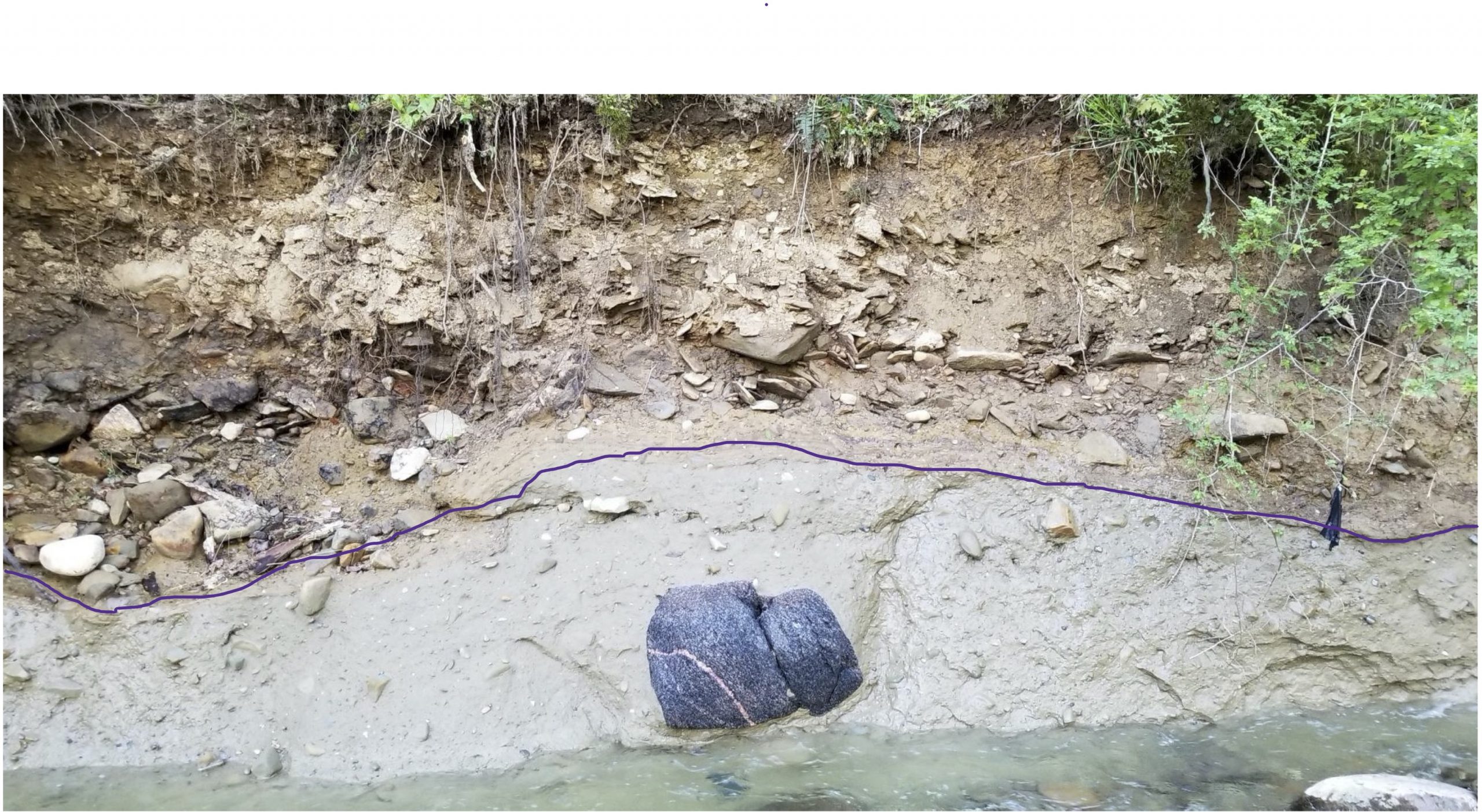 The unconformity – the glacial till below with an gneiss/schist erratic, the Pleistocene below and the Holocene above the line.
The unconformity – the glacial till below with an gneiss/schist erratic, the Pleistocene below and the Holocene above the line.
 Nick took us to some oaks that although second growth were old – here an international team of experts takes some cores.
Nick took us to some oaks that although second growth were old – here an international team of experts takes some cores.
 More cores were taken.
More cores were taken.
 This shale block ripped up by a late summer flood is ephemeral – now three months after the trip this block will be barely recognizable. The ongoing pluvial is ripping apart geology that is over 200 million years old and it is not stopping, it is ramping up and driving our science. Climate change and stormwater management are two fields of Earth Sciences where we need the folks in these photos to understand and help mitigate the societal impacts of these challenges.
This shale block ripped up by a late summer flood is ephemeral – now three months after the trip this block will be barely recognizable. The ongoing pluvial is ripping apart geology that is over 200 million years old and it is not stopping, it is ramping up and driving our science. Climate change and stormwater management are two fields of Earth Sciences where we need the folks in these photos to understand and help mitigate the societal impacts of these challenges.
 We were almost all there that day in September at Browns Lake when we laid down the basics for bog coring later in the semester.
We were almost all there that day in September at Browns Lake when we laid down the basics for bog coring later in the semester.
 Coring on the flat – the margin of the bog, determining the age of the first arrival of trees into the peat land.
Coring on the flat – the margin of the bog, determining the age of the first arrival of trees into the peat land.
 Working at the new Davey Expert Tree Company facility in Kent Ohio – we had two missions: (1) to date the barn at the site soon to be reconstructed at the golf course that will soon be an arboretum and, (2) to core some of the older oaks on the former golf course.
Working at the new Davey Expert Tree Company facility in Kent Ohio – we had two missions: (1) to date the barn at the site soon to be reconstructed at the golf course that will soon be an arboretum and, (2) to core some of the older oaks on the former golf course.

 This group made short work of the white oaks at the site. Dr. Dan Herms (left) was our host. The site also boasts some great bogs and we will be back to core them – likely this summer. We originally went to core larch trees, but found there were none, luckily the group was flexible.
This group made short work of the white oaks at the site. Dr. Dan Herms (left) was our host. The site also boasts some great bogs and we will be back to core them – likely this summer. We originally went to core larch trees, but found there were none, luckily the group was flexible.
 Alex looks like he is deforming this white oak – but his sampling is all non-destructive.
Alex looks like he is deforming this white oak – but his sampling is all non-destructive.
 There were only 5 oaks cored, but they did provide a story. It turns out we were able to show that in the 1920s when the site became a golf course the trees lost their sensitivity to moisture due to irrigation.
There were only 5 oaks cored, but they did provide a story. It turns out we were able to show that in the 1920s when the site became a golf course the trees lost their sensitivity to moisture due to irrigation.
 The other mission was dating the barn. When we got there the barn (above) had been taken down and stored. The class sampled the beams and did the tree-ring work showing the timber was cut in 1888 and 1889 it was built in 1890.
The other mission was dating the barn. When we got there the barn (above) had been taken down and stored. The class sampled the beams and did the tree-ring work showing the timber was cut in 1888 and 1889 it was built in 1890.

The report above is what was submitted to the Davey Expert Tree Company. These results we be on display when the visitor’s center to the new arboretum is built in the coming years.
 Combining the barn data with the living tree data shows the release in growth of the trees in the late 1800s. This is due to a combination of land use changes, perturbations in biogeochemical cycles and climate (pluvial). The good news is the older trees are sequestering more carbon for us; the sad news is that oaks in Ohio will never again growth as slow and deliberate as the tree growth prior to the 1800s (see below).
Combining the barn data with the living tree data shows the release in growth of the trees in the late 1800s. This is due to a combination of land use changes, perturbations in biogeochemical cycles and climate (pluvial). The good news is the older trees are sequestering more carbon for us; the sad news is that oaks in Ohio will never again growth as slow and deliberate as the tree growth prior to the 1800s (see below). Growth rings from a core from the barn – tree rings dated between 1770 and 1780.
Growth rings from a core from the barn – tree rings dated between 1770 and 1780.
 Back to Browns Lake for coring in October.
Back to Browns Lake for coring in October. Like most of our stories of classic paleoclimate records around the world (and Ohio), there is often a hero, someone who can make it work when the call goes out to recover a continuous 10 meters of mud from a kettle. Tom Lowell at the University of Cincinnati finesses his rig as he recovers the record of the last 15,000 years of environmental change.
Like most of our stories of classic paleoclimate records around the world (and Ohio), there is often a hero, someone who can make it work when the call goes out to recover a continuous 10 meters of mud from a kettle. Tom Lowell at the University of Cincinnati finesses his rig as he recovers the record of the last 15,000 years of environmental change.
 Wizards in the woods, Dr. Diefendorf setting up his lab. The UC group is ambitious in their efforts to understand the past. It involves stable isotopes of biomarkers from diatoms and other complex, but promising, ways of understanding the past changes in climate.
Wizards in the woods, Dr. Diefendorf setting up his lab. The UC group is ambitious in their efforts to understand the past. It involves stable isotopes of biomarkers from diatoms and other complex, but promising, ways of understanding the past changes in climate.
 Nick and Justine wrap up the upper meter of core showing the bog (peat) /lake transition.
Nick and Justine wrap up the upper meter of core showing the bog (peat) /lake transition.
 We did our best to do the core justice by dividing into three groups and examining the Bolling-Allerod transition, the 8.2 ka event and the 6 ka pluvial. The take home message is that climate has changed in the past and often abruptly – will our present ride into the greenhouse be smooth or bumpy? How bumpy? This mud truly is a time machine as were were able to pick out those transitions and confirm them (more or less) with C-14.
We did our best to do the core justice by dividing into three groups and examining the Bolling-Allerod transition, the 8.2 ka event and the 6 ka pluvial. The take home message is that climate has changed in the past and often abruptly – will our present ride into the greenhouse be smooth or bumpy? How bumpy? This mud truly is a time machine as were were able to pick out those transitions and confirm them (more or less) with C-14. The last trip to Johnson Woods – posing in front an oak that is 350+ years old. These sentinels of change reveal alot about the past and we can still learn more from them.
The last trip to Johnson Woods – posing in front an oak that is 350+ years old. These sentinels of change reveal alot about the past and we can still learn more from them. The Johnson Woods site – standardized using the signal – free software of E.R Cook. Over 100 series are in this chronology and what it shows is amazing. Major drought years of 1699 and 1810 corresponding with major volcanic events, a steady rise in growth since the time of European Settlement in the early decades of the 1800s and an inferred dry interval during that time. The increasing ring-widths continues until recent decades when the tree-ring series becomes insensitive to moisture (Maxwell et al., 2016). Prior to 1975 the correlation with summer precipitation is high (0.49, N=98 years) after from 1976-2012 the correlation drops to 0.10. It may be that the increases in temperature are now becoming more important to the trees – the correlations with temperature are negative with a strong negative June-August maximum temperature (r = -0.49; N=84) then a drop to -0.33 for 1976-2012. Intriguing also is the strengthening of the negative correlation with winter minimum temperatures (December-February, r=-0.42 (N=27 years) from 1985-2012). Perhaps due to warming night time temperatures and increased tree respiration trees can be stressed. This all needs further study.
The Johnson Woods site – standardized using the signal – free software of E.R Cook. Over 100 series are in this chronology and what it shows is amazing. Major drought years of 1699 and 1810 corresponding with major volcanic events, a steady rise in growth since the time of European Settlement in the early decades of the 1800s and an inferred dry interval during that time. The increasing ring-widths continues until recent decades when the tree-ring series becomes insensitive to moisture (Maxwell et al., 2016). Prior to 1975 the correlation with summer precipitation is high (0.49, N=98 years) after from 1976-2012 the correlation drops to 0.10. It may be that the increases in temperature are now becoming more important to the trees – the correlations with temperature are negative with a strong negative June-August maximum temperature (r = -0.49; N=84) then a drop to -0.33 for 1976-2012. Intriguing also is the strengthening of the negative correlation with winter minimum temperatures (December-February, r=-0.42 (N=27 years) from 1985-2012). Perhaps due to warming night time temperatures and increased tree respiration trees can be stressed. This all needs further study.
 An under rated input into generating good paleoclimate data is a good attitude .
An under rated input into generating good paleoclimate data is a good attitude .
Centuries-old black oak falls on Wooster campus
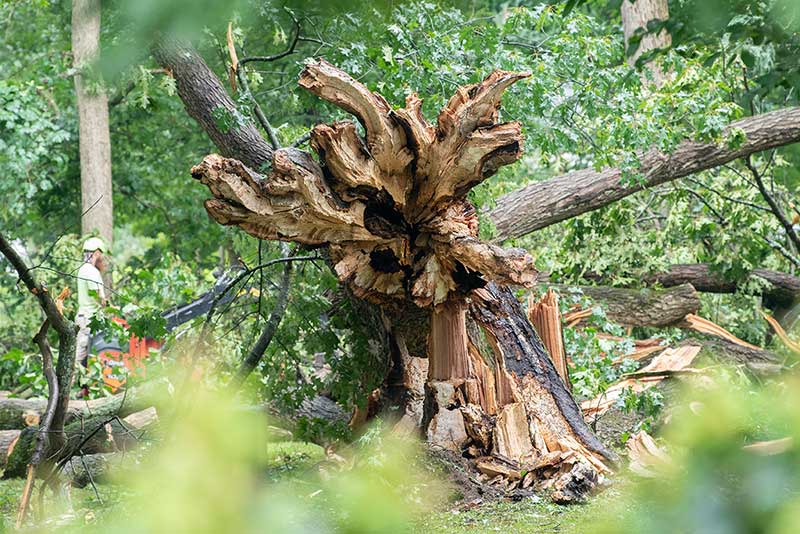
A mighty oak has fallen. An Oak Grove tree that stood for more than two centuries came down on Monday at The College of Wooster.
No people or property were hurt when the black oak (quercus velutina) fell, though it did cause some damage to a nearby white oak tree that caused it to be taken down as well. According to the College’s manager of grounds, Phil Olsen, the tree fell due to what is called “natural failure,” he said. “It happens sometimes, especially this time of year, where the tree could no longer hold itself up because of the moisture in it,” he said. “Everything has an end date and that was it. It’s sad. It was one of the feature trees on our tree walk and one of the oldest stately black oaks on our campus.”
The tree was assessed by Nick Wiesenberg, Geology Technician in Earth Sciences, who determined the tree to be 228 years old.
“With the help of the tree service crew, we were able to obtain a cross-section from the black oak that contained the inner most rings which I cross-dated with other tree ring data from the old oaks on campus,” he said. “Although one of the largest in diameter, it was not the oldest we have sampled on campus.” Olsen recalled having to take down a white oak tree near the tennis courts a few years ago that dated at least 350 years.
The Wooster campus is home to several old oak trees in Oak Grove, the seeds for which were planted as many as 340 years ago, according to a stone tablet located near the fallen tree. “We are so incredibly fortunate to have such amazing trees at the College of Wooster–more than 2,500 trees all together,” President Sarah Bolton told the Daily Record. “Some of the trees, like the black oak that fell this morning, are older than the College itself. Our trees are beautiful, and they carry our history in so many ways.” Our excellent grounds team, led by expert arborist Phil Olsen, cares for all of our trees, tracking and supporting their health, deciding on new plantings, and making sure the campus conserves this precious resource. I am so grateful to Phil and his team for their incredible work and dedication to the thriving of our campus and our community,” she said.
Wooster’s campus has more trees than students and holds an official Tree Campus USA designation.
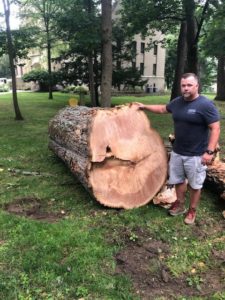
Phil Olsen, Manager of Grounds
Working Remotely with Youth Groups in Southeast Alaska

The groups had a full summer and the tree-ring work was only one of their projects. They traveled by kayak, boat and floatplane across the region, sampling and taking notes on each tree they cored (various photos of the Kake and Angoon groups)

The Hoonah and Klawock teams shown measuring and coring and filling out the survey data.

The AYLS groups from Kake, Hoonah, Angoon and Klawock sampled an extensive portion of Southeast Alaska in the summer of 2021. The groups entered their data in to Survey 123 and Wooster students could check in each day and see the map populate with the sample sites.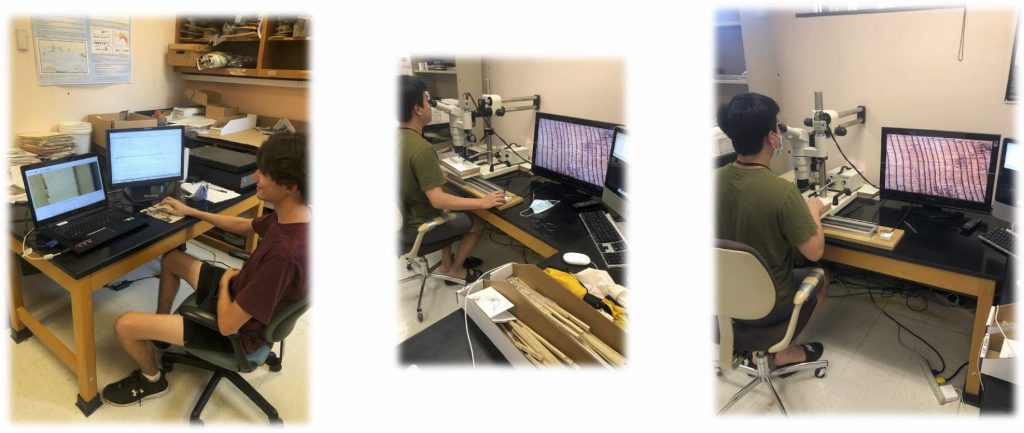
Representative samples from the AYLS groups. These are the first Red Cedar (far left) that the Wooster lab has worked with.
One of the tables showing the combined AYLS and Wooster data set. This was for the Prince of Wales group (Klawock). Three of the cedar trees are over 400 years old.
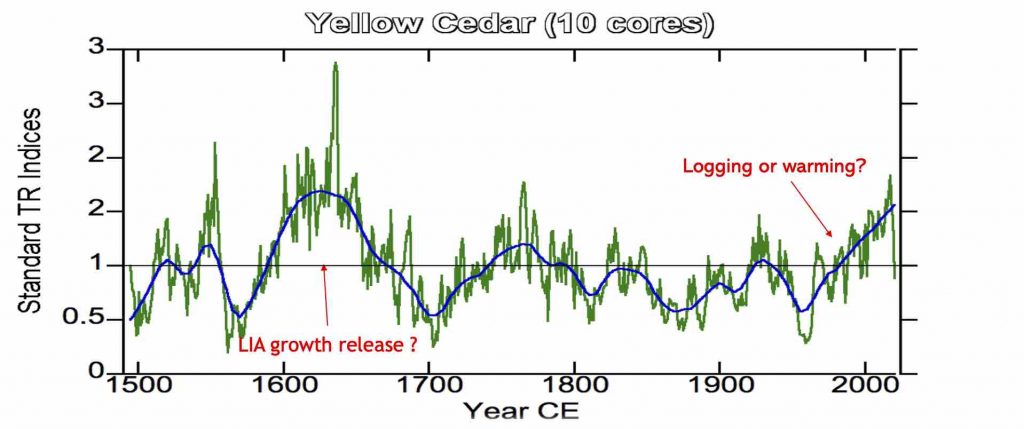
Some of the results included the Yellow Cedar tree-ring record above that brings the LIA (Little Ice Age) increase in growth and a recent release that could be related to warming or logging at a site on Prince of Wales Island.
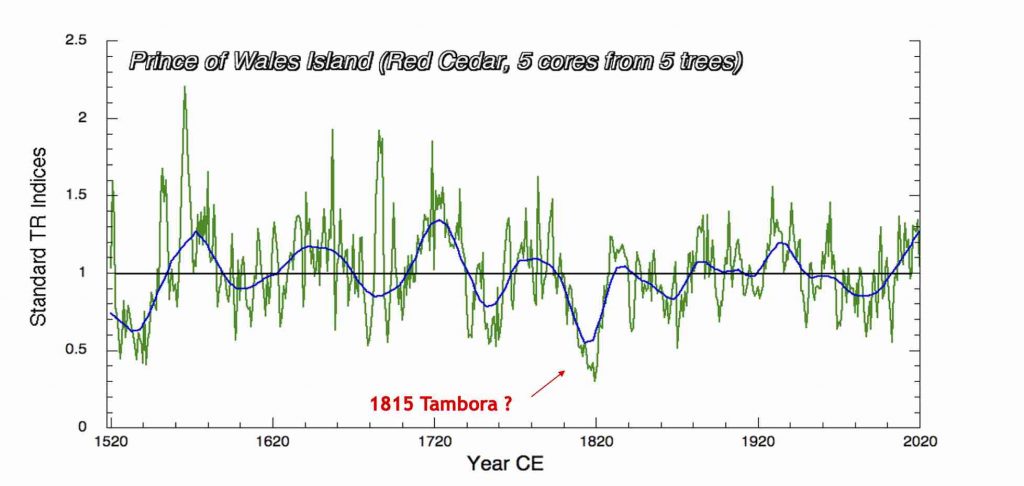
A red cedar chronology appears to record reduced ring-width shortly after the 1815 eruption of Tambora (1816 called the year without summer in Europe) – it may be that the volcanic event forces a change in ocean temperatures that then causes the cooling to persist. Further study is needed.
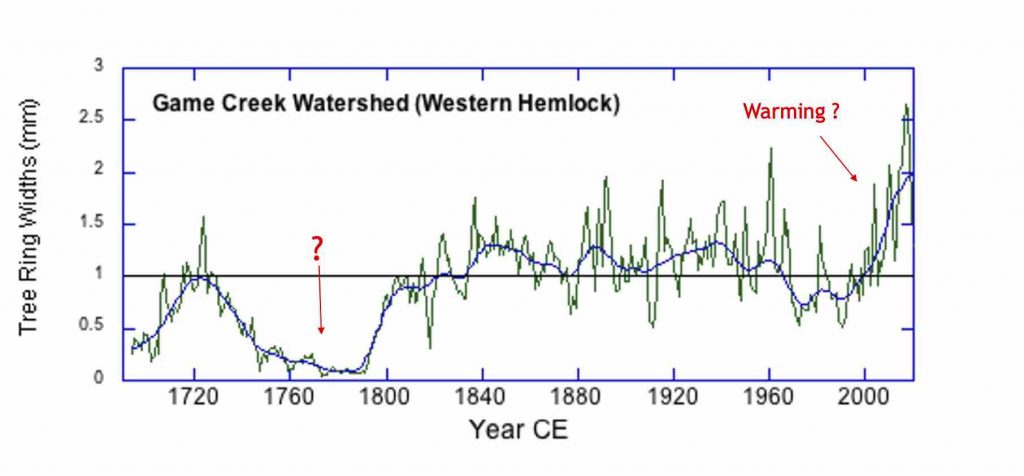
Tree-ring series from Hoonah – these western hemlocks show an interesting suppression of growth in the mid to late 1700s, a change that persists for some decades. Western hemlock here also appear to track the warming well. Again further analysis can test some of the ideas the groups generated about the changes in observed tree growth.
Next summer we hope to visit some of these sites and expand on this work, as well a s continuing our remote collaboration.
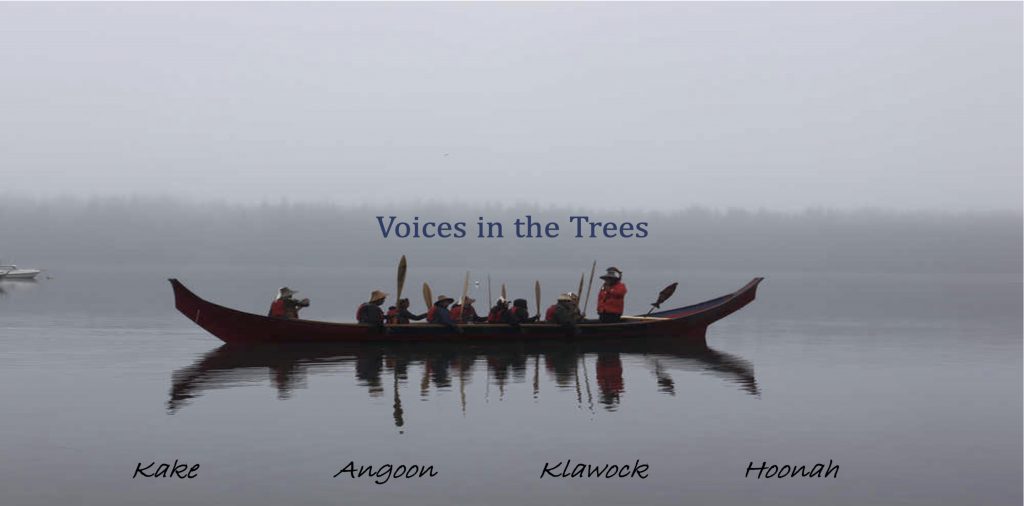
A 40-foot spruce dugout canoes carved in Hoonah by master carver Wayne Price, and apprentices Steven Price, Zack James (Tlél Tooch Tláa.aa) and James Hart (Gooch Éesh) arriving Bartlett Cove, Glacier Bay, Alaska. The trip from Hoonah marked the return of the Tlingit to their ancestral homeland in 2016. Image courtesy of the Juneau Empire, the full story is here.
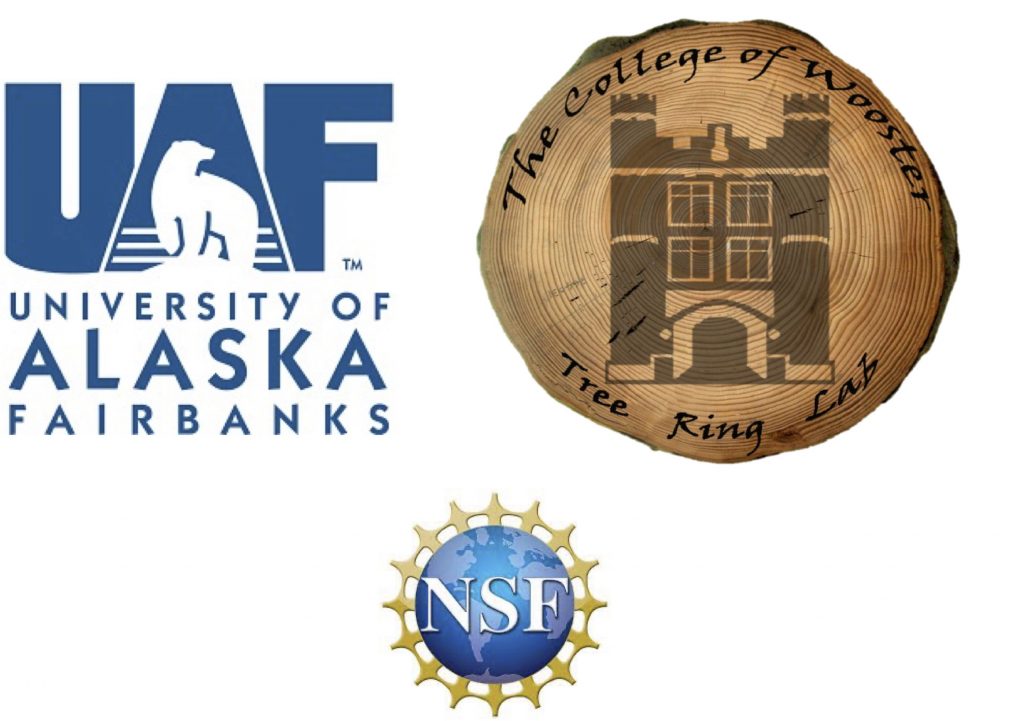
This project was funded by the National Science Foundation Paleoclimate Program (Awards: P2C2-2002561 and 2002454).
Wolf Lake and the Surrounding Landscape, Glacier Bay, Alaska
Members of the Wooster Tree Ring Lab had a great opportunity to travel to a seldom-visited part of Glacier Bay National Park and Preserve – a transect from Wolf Lake to Burroughs Glacier. We were there because there is 2500 year-old forest remnant that was overrun by ice. The ice has gone and continues to melt. Our interest is recovering these logs is to fill a gap millennial-scale tree-ring record from the Gulf of Alaska. The recently exposed logs are being lost to science each year as they flush out into the sea and rot away in this hypermaritime climate. Wooster student independent studies (ISs) in the region quite literally have surrounded this Wolf Lake site with their research, and over the last 10 years we have honed into this key location from all directions.
A view of Mount Wright through a gap in drift and bedrock. Tree-ring records from the flanks of Mt. Wright were part of a study led by Stephanie Jarvis and sampled by Sarah Appleton, who did their thesis work in the region.
We flew into the site this year. In previous years we attempted to walk in twice and once we were successful. I recommend the flying



